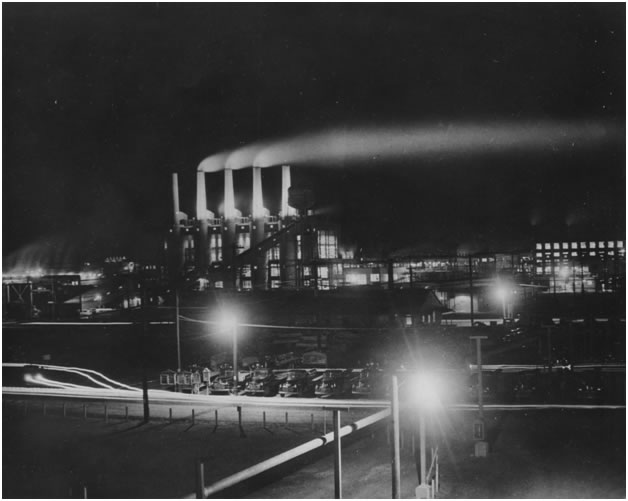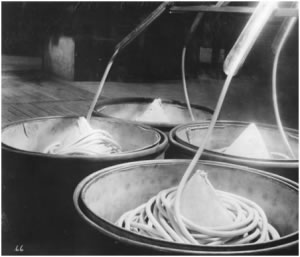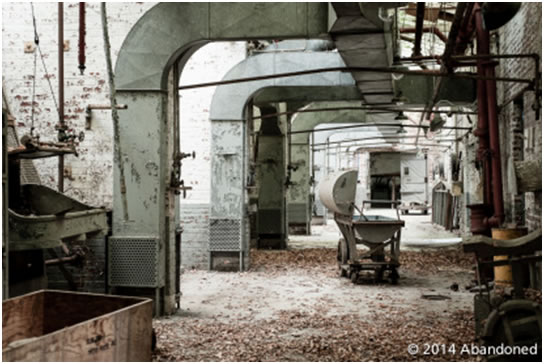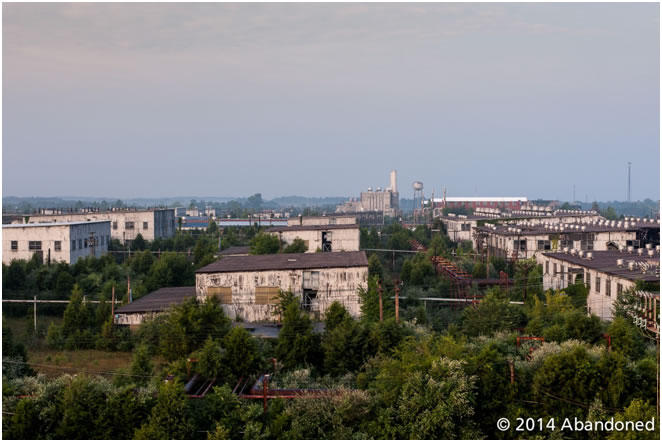
Indiana Ordnance Works, 1940s, Image courtesy of Hagley Digital Archives.
IHB recently completed research and marker text for the massive WWII smokeless powder plant in Charlestown, Indiana known as the Indiana Army Ammunition Plant. The plant received multiple military awards for production, transformed the local community and bolstered its economy, and provided job opportunities for women and African Americans. This marker helps fill a void in the State Historical Marker Collection by commemorating Indiana’s WWII home front and the contributions of Hoosier men and women to the war effort.
At the outbreak of war in Europe in September 1939, the Allied Powers desperately needed war supplies to combat Germany’s war resources, as the country had been producing material since the early 1930s. In response, the U.S. established an extensive ordnance system, hoping in part to stave off their own involvement in war. The Evacuation of Dunkirk in May 1940 and Fall of France in June greatly hastened U.S. efforts to construct ordnance plants and resulted in the establishment of the smokeless powder plant in Charlestown. Smokeless powder was crucial to combat because traditional smoke obscured combatants’ vision and revealed their location. Smokeless powder, made from colloided nitrocellulose, acted as the primary explosive propellant for various war ammunition.

Cords of smokeless powder before being cut into appropriate sizes, 1940s, Image courtesy of Hagley Digital Archives.
Steve Gaither and Kimberly L. Kane contend in their comprehensive 1995 The World War II Ordnance Department’s Government-Owned (GOCO) Industrial Facilities: Indiana Army Ammunition Plant Historic Investigation that the smokeless powder plant in Charlestown, referred to as the Indiana Ordnance Works 1 (IOW1), was one of the first ordnance plants in the nation established to meet WWII war material needs. The southern Indiana town of 939 residents was chosen as the plant site because of its inexpensive land, ready labor force, close proximity to railroads, massive water supply provided by the Ohio River and removal from the country’s borders to avoid bombing or invasion.
Former Charlestown resident Mary T. Hughes described Charlestown to the Indianapolis Times in November 1940 as a “quiet, easy going upland town-one of those southern Indiana towns where rambling homes line the shaded streets and the still peace of the afternoon is like Sunday.” Walter A. Shead similarly profiled the town in a December 1940 Madison [IN] Courier article, stating that Charlestown “has watched the years slip past through the century without even the quickening of a pulse-beat . . . most of whom are retired farmers, has lived the simple life undisturbed by modern conveniences or the quickened tempo of present-day life.” Unsurprisingly, the influx of thousands of workers and rapid industrialization shocked the small town.
Shortly after Congress passed funding for munitions production on July 1, 1940, the federal government awarded E.I. deNemours DuPont Co. a war contract to establish IOW1. The arrangement, known as a Government-Owned Contractor-Operated (GOCO) collaboration, was undertaken frequently in WWII. In GOCO collaborations the federal government owned the ordnance plant and a business experienced in mass production was responsible for plant design, construction and operations. Soon after DuPont was awarded the contract, agents arrived in Charlestown to purchase properties including businesses, churches, farms and private residences to build the plant, affording local residents unheard of economic opportunities.

Purchased house, Indiana Ordnance Works Real Estate Acquisition 1941, Charlestown, Indiana, Image courtesy of Indiana Memory Digital Collections.
When construction began that summer thousands of workers from around the nation flooded the small community, hosting 30,000 transient workers at the peak of construction. An article in the September 13, 1940 Louisville Courier-Journal vividly described the transformation, stating:
“. . . farm houses were being wrecked. In that wreckage could be seen bruised and tangled masses of cultivated flowers, some in bloom, and imported shrubbery. The fields which this spring were planted in corn, soybeans and other crops were being subjected to the same treatment as if they had contained ragweed. Ears of golden yellow corn were being trampled underfoot by the workmen or ground under the wheels of motor cars.”
In addition to the smokeless powder plant, the federal government worked with the Goodyear Tire and Rubber Company in early 1941 to establish a bag-loading plant known as the Hoosier Ordnance Plant (HOP). HOP workers weighed, assembled and packed smokeless powder into silk bags. HOP, along with an uncompleted double-base rocket powder plant, Indiana Ordnance Works 2 (IOW2), drew thousands of construction and production workers to the area.

Mixer House Building 208, 2014, Image courtesy of Abandoned Online.
Housing these workers became the town’s most immediate problem, as Charlestown had approximately 235 existing homes and one hotel so crowded that “you can’t get a room for love or money” (Gary-Post Tribune, December 1940). Indianapolis newspapers reported that new arrivals were so desperate for housing that they lived in trailers, cars, chicken coops, barns, lean-tos and even the town jail. A Charlestown Courier article colorfully reported in February 1941 “It may have been a hen house, wash house, wood house, garage or what have you for lo, these many years, but the minute it has been insulated, windows and chimney installed and Powder Plant workers have moved in and hung lace curtains, it becomes a guest house.”
Another immediate problem facing Charlestown was the town’s lack of rudimentary sanitation systems. According to a 1942 public health survey, prior to the plants’ establishment the town had no systematic trash or human waste disposal program. Additionally, Charlestown lacked a public water supply, depending primarily on private wells and cisterns. The absence of sanitary accommodations caused residents and officials to worry about epidemics. The 1942 survey reported “The dangers to health flowing from a congestion of workers drawn from north and south and east and west, eating and sleeping under the most elementary conditions, crowded into inadequate quarters and served by water, milk, and sanitary facilities designed for a small community can hardly be exaggerated.” The establishment of trailer camps, accommodating hundreds of workers and their families in close proximity, worsened these fears. Conditions proved so precarious that even the town jail was condemned and closed by the State Board of Institutions for sanitation reasons.

Charlestown, 2014, Image courtesy of Abandoned Online.
The overcrowding of local businesses, infrastructure and sanitation facilities generated tension between local residents and transient workers regarding who should shoulder the burden. A Madison [IN] Courier article explained that “Native folks in Charlestown are a little dazed, for they hardly know just what to make of this hub-bub which has come to shake the even tenor of their ways, a manner of life which has endured for more than a century.” Locals often labeled newcomers “du Ponters” and their children as “powder children” in an effort to differentiate themselves. Conversely, Margaret Christie reported in the Indianapolis Star that many migrant workers resented the implication that locals considered them “’trailer trash.” Debates between local residents and transient workers played out publicly in letters to editors of local newspapers. For the most part, however, locals adjusted to the influx of transients and Charlestown permanently benefited from their patronage.
Check back for Part II to learn about how the ordnance facility led to permanent improvement of the town, the use of German POWs, and how the plants ushered women and African Americans into the WWII labor force.

